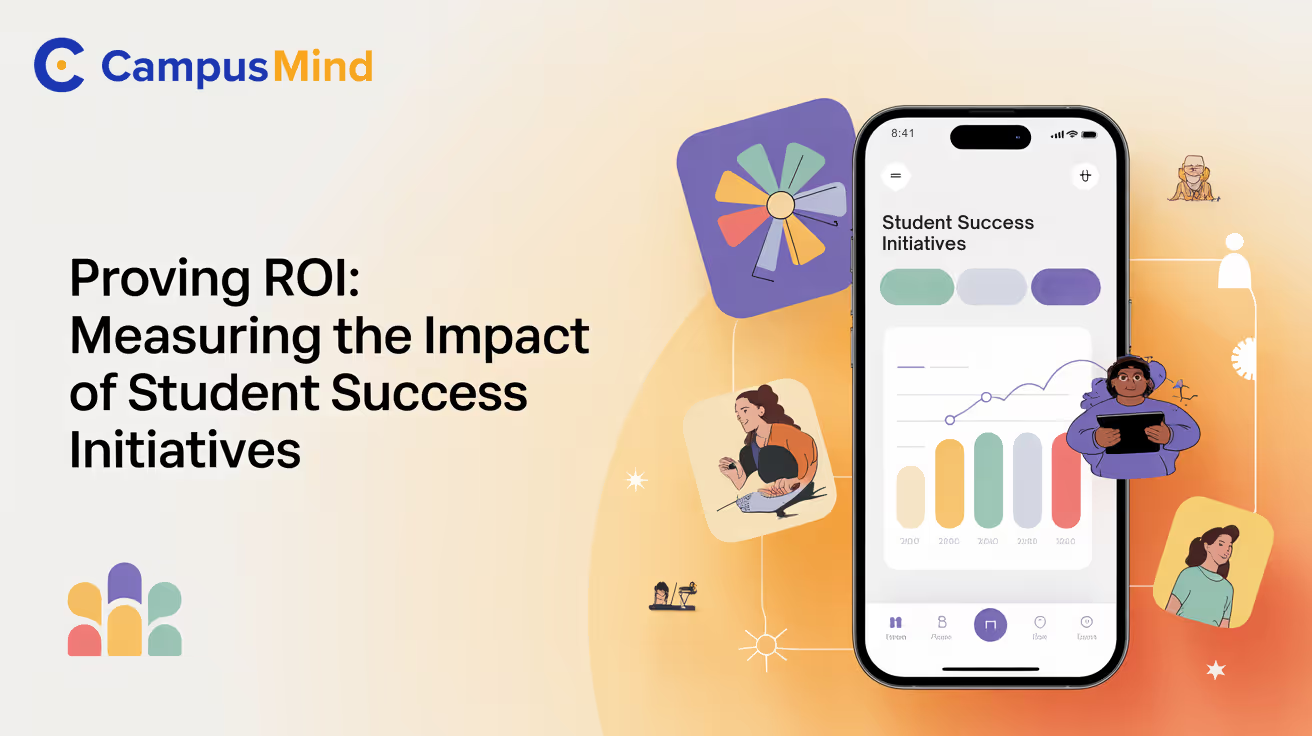The Money Talk Nobody Wants to Have (But Everyone Needs)
Picture this: You're sitting across from your CFO, and they're looking at you with that expression. You know the one. It's the "show me the money" face that makes every student affairs professional's stomach drop.
"These retention programs are great," they say, tapping their pen on a spreadsheet. "But what's the actual return on investment?"
If you're like most student success leaders, you probably have a dozen heartwarming stories about students whose lives were changed by your programs. But heartwarming doesn't move budget lines. Numbers do.
Here's the good news: Those student success programs you're fighting for? They typically generate returns between 2:1 and 8:1. That means for every dollar invested, institutions see two to eight dollars back. And we're not making this up—we have the receipts.
Real Schools, Real Numbers, Real Impact
Let's start with Wayne State University, because their story might sound familiar. Back in 2011, they were struggling with retention like everyone else. They decided to invest $2 million annually in student success programs. By 2018, that investment had grown to $4 million.
The result? Wayne State now generates more than $1 million in annual surplus from tuition revenue from retained students. They're not just breaking even—they're making money while helping students succeed. Oh, and they increased graduation rates by 20 percentage points along the way.
But maybe you're thinking, "That's a big state school with deep pockets. What about smaller institutions?"
Take a look at the University of Southern Mississippi. They invested in something simple: faculty development through the ACUE Faculty Certification Program. The return? They generated $720,000 from 139 retained students, achieving an 8:1 return on investment. For every faculty member who went through the training, two additional students stayed in school.
And here's what really gets budget committees excited: Middle Tennessee State University saw $1.5 million in spring tuition revenue from 390 additional retained students within just 120 days of launching their Navigate platform. That's not a multi-year projection. That's one semester.
The Hidden Costs of Losing Students (That Your CFO Already Knows)
Every time a student drops out, your institution doesn't just lose their tuition. You lose so much more.
First, there's the replacement cost. According to recent data, recruiting a replacement student costs private institutions an average of $2,795 and public institutions $494. Every student who stays is one less recruitment bill to pay.
Then there's the state funding hit. Right now, 32 states tie public university funding to performance metrics, with retention being a major component. In Tennessee, virtually all state support depends on these metrics. When students leave, state dollars leave with them.
But wait, there's more (as the infomercials say). Students who stay also pay for housing, meal plans, parking, and textbooks. These auxiliary revenues typically add $3,000-$8,000 per student annually. When a residential student drops out, that's a $10,000+ annual hit to your bottom line.
Why Now? Because the Clock is Ticking
If you've been paying attention to higher education news, you know we're heading for a cliff. The demographic cliff means institutions will face a 13% decline in traditional-age college students by 2041. That's 576,000 fewer students nationally.
The good news? National retention rates just hit 68.2% in 2024—the highest in a decade. Schools that are investing in student success are seeing results. The ones that aren't? They're the ones closing at a rate of one per week.
Your CFO knows this. They've seen the projections. Moody's downgraded the entire higher education sector outlook to negative in March 2025. In this environment, programs that generate positive ROI aren't nice-to-haves. They're survival tools.
The Simple Math That Wins Budget Battles
Here's how to calculate ROI in a way that makes sense to everyone at the table:
Basic Formula: ROI = (Revenue from Retained Students - Program Costs) ÷ Program Costs × 100
Let's use real numbers. Say you invest $350,000 in a comprehensive retention program for 500 at-risk students. Your current retention rate for this group is 60%. Your goal is to get it to 75%.
15% improvement = 75 additional students retained
75 students × $7,500 average net tuition = $562,500 in additional revenue
$562,500 - $350,000 investment = $212,500 net gain
ROI = 61%
And that's just year one. Those 75 students will likely stay through graduation, generating revenue for 3-4 more years.
What Works (And What's Worth Your Money)
Not all interventions are created equal. Based on verified data from multiple institutions, here's what delivers the best returns:
Early Alert Systems: These consistently show the highest ROI because they're relatively inexpensive and catch problems before students disappear. Schools report 4:1 to 5:1 returns.
Peer Mentoring: Low cost, high impact. The University of Southern Mississippi's program showed 2:1 ratio of additional students retained per participating faculty member. Students trust other students, and peer mentors cost less than professional staff.
Proactive Academic Advising: When advisors reach out instead of waiting for students to show up, retention improves by 3-5 percentage points. The technology to enable this typically pays for itself within one semester.
Comprehensive First-Year Programs: Yes, they're expensive. But California State University Fullerton's investment generated $29 million+ return on investment over three years. Sometimes you have to spend money to make money.
The Elephant in the Room: What We Don't Know
Let's be honest about something. You might have heard that "68% of institutions struggle to predict retention intervention outcomes." We searched everywhere for this statistic, including all of Tyton Partners' published research, and couldn't verify it.
What Tyton Partners actually found was different but equally important: 60% of students aren't even aware of the support services available to them. You can't measure ROI on programs students don't know exist.
This is why tracking and measurement matter so much. You need to know not just what you're spending, but whether students are actually using your services and whether those services make a difference.
Making Your Case: A Playbook for Success
Start Small and Prove It
Ivy Tech Community College's CFO, Chris Ruhl, shared a brilliant approach. They started with a pilot program for 21st Century Scholars. The program improved retention by 8.8 percentage points (from 36.9% to 45.7%) and paid for itself in approximately 3 years.
The key? They used conservative projections and beat them. Under-promise and over-deliver.
Use Peer Comparisons
Your CFO will want to know what similar schools are doing. California State schools using coordinated retention programs are seeing 3-15% graduation rate improvements. When 15 North Carolina community colleges implemented coaching for stopped-out students, they generated $3.5 million in institutional ROI since 2021.
Show the Opportunity Cost
Frame it this way: "We can spend $350,000 on retention programs that will generate $562,500 in revenue, or we can spend $419,250 recruiting 150 replacement students who might not even enroll." Which sounds like a better investment?
Present Multiple Scenarios
Create three projections:
Conservative (2% retention improvement)
Moderate (4% retention improvement)
Optimistic (6% retention improvement)
Show positive ROI even in the conservative scenario. This builds credibility.
Beyond the Dollars: Secondary Benefits That Seal the Deal
While tuition revenue gets the headlines, smart leaders know the full story includes:
Performance Funding Bonuses: States like Tennessee provide $300 per student completing 15 credit hours plus $4,000 per graduate bonuses. These add up fast.
Alumni Giving: Students who graduate are more likely to donate. Schools with 96% graduation rates see 41% alumni giving rates. Every retained student is a potential future donor.
Reputation and Rankings: Retention rates factor into college rankings. Better rankings mean easier recruitment and potentially higher tuition rates.
Faculty Morale: Professors prefer teaching students who stay. Lower dropout rates mean happier faculty, which means better teaching, which means... you get the cycle.
The Conversation Script That Works
When you sit down with your CFO, try this approach:
"I know budgets are tight. That's exactly why we need to invest in retention. Here's what peer institutions are seeing: 2 to 8 times return on investment. I'm proposing we start with a $200,000 pilot program targeting 300 at-risk freshmen.
If we improve retention by just 3 percentage points—which is conservative based on what similar schools achieve—we'll generate $337,500 in additional tuition revenue. That's a $137,500 net gain in year one, not counting state funding bonuses or auxiliary revenue.
More importantly, we'll learn what works for our students. We can scale what succeeds and cut what doesn't. Either way, we'll have data, not guesses."
Your Next Steps (Yes, Today)
Calculate your current cost per dropout. Include recruitment replacement, lost auxiliary revenue, and state funding impacts. This number will shock people—in a good way for your case.
Identify your highest-impact opportunity. Look at where you're losing the most students. First-to-second year? Fall to spring? Target the biggest leak in your pipeline.
Find your peer comparisons. NACUBO's Student Success Hub has 26 institutions sharing their financial data and ROI calculations. Use their successes to build your case.
Start tracking everything. You can't improve what you don't measure. Set up systems to track program participation, student outcomes, and financial impacts from day one.
Build your coalition. Finance folks respond to finance arguments. Get your CFO on board as a partner, not an adversary. Show them how student success programs solve their budget problems.
The Bottom Line (Literally)
Student success programs aren't just the right thing to do—they're the smart financial move. In an era of demographic cliffs, budget cuts, and weekly college closures, institutions that invest in keeping students are the ones that will survive and thrive.
The evidence is clear. The math works. The only question is whether you'll make the case or watch your competitors do it first.
Your students need these programs. Your institution needs the revenue. And now you have the numbers to prove that everyone wins when students succeed.
Ready to build your ROI case? Start with one program, track everything, and let the numbers tell the story. Your CFO might just become your biggest advocate.
After all, there's nothing financial leaders love more than investments that pay for themselves.
Works Cited
[1] Gyurko, Jonathan — "Retention, ROI, and Student Success." Medium. Published: 2023. Accessed: 2025-09-07.
[2] EAB — "Why your student success strategies can (and should) pay for themselves." https://eab.com/insights/blogs/student-success/business-case-for-student-success/. Published: 2024. Accessed: 2025-09-07.
[3] InsideTrack — "ROI of student success programs: Strategies for maximizing impact." https://www.insidetrack.org/blog/maximizing-roi-on-your-next-student-success-initiative. Published: 2024. Accessed: 2025-09-07.
[4] EAB — "Student Success Case Study Compendium." https://eab.com/why-eab/partner-stories/student-success-compendium/. Published: 2024. Accessed: 2025-09-07.
[5] Center on Budget and Policy Priorities — "State Higher Education Funding Cuts Have Pushed Costs to Students." https://www.cbpp.org/research/state-budget-and-tax/state-higher-education-funding-cuts-have-pushed-costs-to-students. Published: 2024. Accessed: 2025-09-07.
[6] Center for American Progress — "Performance-Based Funding of Higher Education." https://www.americanprogress.org/article/performance-based-funding-of-higher-education/. Published: 2024. Accessed: 2025-09-07.
[7] Deloitte Insights — "2025 Higher Education Trends." https://www2.deloitte.com/us/en/insights/industry/public-sector/2025-us-higher-education-trends.html. Published: 2025. Accessed: 2025-09-07.
[8] National Student Clearinghouse — "First-year Persistence and Retention Rates Reach 10-Year High." https://www.studentclearinghouse.org/nscblog/first-year-persistence-and-retention-rates-reach-10-year-high/. Published: 2024. Accessed: 2025-09-07.
[9] Tyton Partners — "Driving Toward a Degree 2023 Study." https://tytonpartners.com. Published: 2023. Accessed: 2025-09-07.
[10] NACUBO — "Student Success Hub." https://www.nacubo.org. Published: 2024. Accessed: 2025-09-07.
[11] Parkay, Susan — "How One Community College CFO Models ROI for Student Success Initiatives." LinkedIn. Published: 2024. Accessed: 2025-09-07.[12] CliffsNotes — "Analyzing Alumni Giving Rates: Insights from School Comparisons." https://www.cliffsnotes.com/study-notes/27401732. Published: 2024. Accessed: 2025-09-07.




